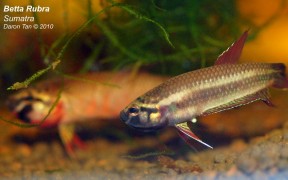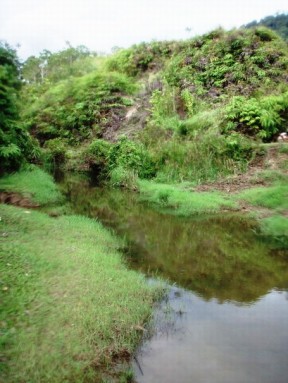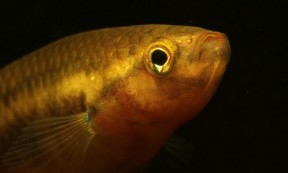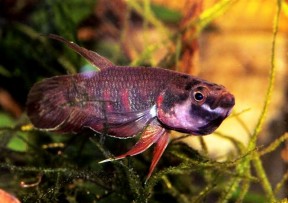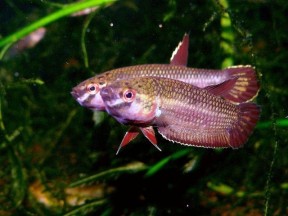Betta dennisyongi
Etymology
dennisyongi: named for Dennis Yong Ghong Chong ‘a distinguished and knowledgeable naturalist well experienced in many facets of tropical Southeast Asian fauna and flora with an avid interest in labyrinth fishes’.
Classification
Order: Perciformes Family: Osphronemidae
Distribution
Currently known only from the western coast of central Aceh province, northwestern Sumatra, Indonesia, between the city of Meulaboh and lowland hill streams north of the town of Singkil.
Type locality is ‘Sumatra: Aceh: Kabupaten Nagan Raya: Lamie, Alue Rayeuk, stream along road Meulaboh-Blangpidie’.
Some former localities for the congener B. rubra are currently considered to refer to B. dennisyongi and it’s unclear if the two occur together naturally in some locations due to human interference (Tan, 2013).
Habitat
Has been collected from lowland hillstreams and acidic freshwater swamps containing clear to brownish water.
One hill stream habitat contained relatively fast flowing clear water with a pH of 7.0), a sandy substrate and steep clay banks, with the fish collected among submerged leaf litter.
The type series was collected from submerged leaf litter and marginal vegetation in slowly-moving brown water with a pH of 6.0 and a substrate of mud and clay.
Syntopic fish species include Osteochilus jeruk, Rasbora jacobsoni, R. kluetensis, Nemacheilus tuberigum, Mystus punctifer, Ompok brevirictus and Kryptopterus piperatus (Tan, 2013).
Maximum Standard Length
30 – 35.5 mm.
Aquarium SizeTop ↑
An aquarium with base measurements of 45 ∗ 30 cm or equivalent is sufficient for a single pair, with something larger required for a group.
Maintenance
Can be maintained in a fully-decorated aquarium although many breeders prefer not to use a substrate for ease of maintenance.
Driftwood roots and branches can be used and placed such a way that a few shady spots are formed while clay plant pots or lengths of piping can also be included to provide further shelter.
The addition of dried leaf litter further emphasises the natural feel and as well as offering additional cover for the fish brings with it the growth of microbe colonies as decomposition occurs.
These can provide a valuable secondary food source for fry and the tannins and other chemicals released by the decaying leaves are also considered beneficial for fishes from blackwater environments.
There is no need to use natural peat, however, the collection of which is both unsustainable and environmentally-destructive.
Like others in the genus this species seems to do best under fairly dim lighting.
You could add aquatic plant species that can survive under such conditions such as Microsorum, Taxiphyllum or Cryptocoryne spp., and a few patches of floating vegetation would be useful as well.
This species should ideally be kept in conditions with negligible carbonate hardness and very low general hardness so a reverse osmosis unit or other method of obtaining soft water may need to be employed, and this can be further acidified using phosphoric acid or similar if necessary.
Filtration need not be too strong, with an air-powered sponge filter set to turn over gently adequate.
Keep the tank well-covered and do not fill it to the top as like all Betta spp. it requires occasional access to the layer of humid air that will form above the water surface, and is an excellent jumper.
Water Conditions
Temperature: 22 – 27 °C
pH: 5.0 – 7.0
Hardness: 18 – 90 ppm
Diet
Likely to feed mostly on insects and other small invertebrates in nature.
Captive fish will normally accept dried products once they’re recognised as edible, but should be offered plenty of small live or frozen foods such as Daphnia, Artemia or bloodworm regularly to ensure development of optimal colour and condition.
Small insects such as newly-hatched crickets or Drosophila fruit flies are also suitable to use; it’s best to fill the stomachs of these by feeding them fish flakes or some kind of vegetable matter before offering them to the fish.
Take care not to overfeed as Betta spp. seem particularly prone to obesity.
Behaviour and CompatibilityTop ↑
Not recommended for the standard community set-up for reasons already touched upon.
It’s requirements and disposition mean it’s best kept alone or with very peaceful species since much bigger or more vigorous fishes are likely to intimidate and outcompete it.
Some small cyprinids and loaches that inhabit similar environments in nature are compatible, but be sure to research your choices before purchase.
Mixed reports exist as to whether it can be maintained in multiple pairs or harem-type groups comprising a single male alongside several females.
Some state that although some chasing and squabbling over territory occurs actual physical damage is rare, while others recommend keeping it in single pairs having observed sustained aggression towards conspecifics from the dominant individuals in a group.
Sexual Dimorphism
Males are more colourful and develop more-extended unpaired fins than females.
Reproduction
Paternal mouthbrooder. Ideally organise a separate tank for breeding purposes unless the fish are already being maintained alone, setting this up as suggested above.
This should have the tightest-fitting cover you can find (some breeders use clingfilm instead to ensure no gaps) as the fry need access to a layer of warm, humid air without which development of the labyrinth organ can be impaired.
Following a protracted courtship eggs and milt are released during an ’embrace’ typical of osphronemids in which the male wraps his body around that of the female, and several ‘dummy’ embraces may be required before spawning itself commences.
In contrast to the majority of mouthbrooding Betta spp. the eggs are not caught in the anal-fin of the male but that of the female as is typical in bubble-nesting congeners.
The male then collects the eggs directly in his mouth and the cycle is repeated until the female is spent of eggs, a process which can take some time.
A brooding male may swallow or release the eggs prematurely if stressed or inexperienced, so it’s preferable to leave the female in situ.
The incubation period is 10-17 days at the end of which the male will begin to release fully-formed, free-swimming fry.
At this point they can be removed or left to grow alongside the parents, with some reports suggesting they actually grow more quickly under such circumstances.
The fry are large enough to accept motile foods such as microworm and Artemia nauplii immediately, though it should be noted that there exist reports of young Betta developing health issues if fed excessive amounts of the latter.
Offer small amounts of different foods 2 -3 times per day for optimal growth rate, and don’t change too much water at once, with regular, small changes preferable to intermittent larger ones.
NotesTop ↑
This species is available in the aquarium hobby but is not traded in large numbers and may have been inadvertently hybridised with the similar-looking congener B. rubra prior to its description since the two are typically exported mixed together.
It’s included in the B. rubra group of closely-related species within the genus, an assemblage erected by Schindler and van der Voort (2012) who also redescribed B. rubra, but both group and species were subsequently redefined by Tan (2013) who also described B. dennisyongi in the same publication.
Following Tan (2013) members of the B. rubra group are defined by the following shared characters: no vertical bars on operculum; operculum pattern comprising a continuous or interrupted post-orbital stripe extending to the edge or almost to the edge of the opercle with its posterior portion enlarged to form a bar-like marking; broad suborbital stripe always present and covering 2-5 scale rows, forming a triangular marking; anal-fin with 2-4 spinous and 22–25 soft rays (total = 25–27); lateral scales 29–32; males and females both with pointed dorsal and anal fins, caudal-fin rounded with extended median rays; mature males with 4–8 broad black lateral bars; females and juveniles with longitudinal black lateral stripe ; found in lowland habitats of northwestern Sumatra; size up to 42 mm SL.
B. dennisyongi can be told apart from B. rubra, currently the only other member of the group, by the following combination of characters: black postorbital stripe continuous and extending to edge of opercle (vs. stripe interrupted in B. rubra); relatively broad suborbital stripe below eye forming a triangular black mark (4–5 scale rows wide, vs. 2–3); less intense body colouration with wider interspaces between the black body bars in males; fewer anal-fin rays (mode 25, vs. 27); more subdorsal scales (6–7, vs. 5–5½); more lateral scales (mode 31, vs. 30); more vertebrae (mode 30, vs. 29); longer dorsal-fin base (13.0–18.4, vs. 11.0–13.4% SL); smaller maximum size (35.4 vs. 42.1 mm SL).
The genus Betta is the most speciose within the family Osphronemidae with almost 70 recognised members and looks set to grow further with new ones continuing to be described on a regular basis since the turn of the century.
Betta species have successfully adapted to inhabit a variety of ecological niches from stagnant ditches to flowing hill streams including some extreme environments such as highly acidic peat swamp forests.
The referral of members to a number of putative groups containing closely-related species is now generally accepted but largely based on morphological and behavioural characters meaning molecular phylogenetic work may prove useful in more precisely determining relationships between these fishes.
A full list of the species groups as currently recognised can be found here.
Like others in the suborder Anabantoidei this species possesses an accessory breathing organ known as the labyrinth.
So-called due to its maze-like structure this organ allows the fish to breathe atmospheric air to a certain extent.
Comprising paired suprabranchial organs formed via expansion of the epibranchial (upper) section of the first gill arch and housed in a chamber above the gills, it contains many highly-vascularised, folded flaps of skin which function as a large respiratory surface.
Its structure varies in complexity between species, tending to be better-developed in those inhabiting harsher environments.
References
- Tan, H. H., 2013 - Raffles Bulletin of Zoology 61(1): 323-330
The identity of Betta rubra (Teleostei: Osphronemidae) revisited, with description of a new species from Sumatra, Indonesia. - Schindler, I. and J. Schmidt, 2006 - Zeitschrift für Fischkunde 8(1/2): 47-69
Review of the mouthbrooding Betta (Teleostei, Osphronemidae) from Thailand, with descriptions of two new species. - Schindler, I. and S. van der Voort, 2012 - Bulletin of Fish Biology 13(1/2): 21-32
Re-description of Betta rubra Perugia, 1893 (Teleostei: Osphronemidae), an enigmatic fighting fish from Sumatra. - Tan, H. H. and P. K. L. Ng, 2005a - Raffles Bulletin of Zoology Supplement 13: 115-138
The labyrinth fishes (Teleostei: Anabantoidei, Channoidei) of Sumatra, Indonesia. - Tan, H. H. and P. K. L. Ng, 2005b - Raffles Bulletin of Zoology Supplement 13: 43-99
The fighting fishes (Teleostei: Osphronemidae: Genus Betta) of Singapore, Malaysia and Brunei. - Witte, K.-E. and J. Schmidt, 1992 - Ichthyological Exploration of Freshwaters 2(4): 305-330
Betta brownorum, a new species of anabantoids (Teleostei: Belontiidae) from northwestern Borneo, with a key to the genus.
